![]()
![]()
![]()
Use LEFT and RIGHT arrow keys to navigate between flashcards;
Use UP and DOWN arrow keys to flip the card;
H to show hint;
A reads text to speech;
67 Cards in this Set
- Front
- Back
|
Essential Elements of Management
|
Goals
Process Resources |
|
|
Main management tasks
|
Planning
Organizing Leading Controlling |
|
|
Main management approaches
|
Classical or Scientific approach
Human relations approach Systems approach Contingency approach Modern approaches |
|
|
Different levels of management
|
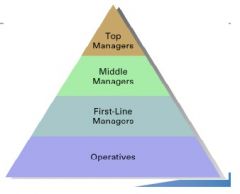
|
|
|
Essential elements of an organization
|
People
Goals Structure Management |
|
|
Basic components of an organization structure
|
Top management
Middle management Operational core Organisational support Operational support |
|
|
Factors affecting organization design
|
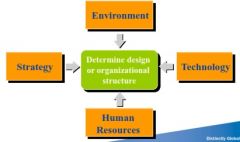
|
|
|
Mintzberg’s Five Type of Organisation Structure
|
Small, or entrepreneurial, structure
Machine bureaucracy Divisionalised structure Professional bureaucracy Adhocracy |
|
|
Characteristics of Project based Organisations
|
Decisions are not repetitive. Early decisions have impact on later decisions.
Learning time for members is limited. Work pattern is not well defined. Personnel are drawn from many organisations (matrix structure). Personnel may work on multiple projects simultaneously (matrix structure). Project organisation changes over different stages |
|
|
Personality characteristics
|
Independence
Conscientiousness Agreeableness Self-control |
|
|
Personality study approaches
|
Nomothetic approach:
Approach claims that personality is largely inherited & resistant to change Ideographic approach: Personality development is viewed as a process & is open to change |
|
|
Big Five Factors (Personality Traits)
|
extroversion/introversion
agreeableness/hostility conscientiousness/heedlessness emotional stability/instability openness or intellect/closed-mindedness |
|
|
Personality: Its Application in the Workplace
|
Organisations regard personality as being of key
significance in decision-making Personality is taken into consideration at the selection interview Personality is a powerful determinant of a manager’s effectiveness |
|
|
Factors Affecting an Individual’s Perceptual Set
|

|
|
|
Selection of stimuli (perception)
|
Grouping – the way in which a manager may think of a group of staff
Figure & ground – a manager may notice a new recruit & set that person apart from the rest because of particular characteristics such as appearance Closure – the degree to which unanimity is perceived |
|
|
Selecting Information (perception)
|
Verbal – what is said
Non verbal (body language) – Bodily contact Proximity to others Posture Head nods Facial expression Gestures Direction of gazes, etc |
|
|
Common stereotypes (perception)
|
Nationality
Occupation Age Physical attributes Education Social status Politics |
|
|
Perception processes
|
Language
Cultural differences Selecting information Stereotyping Halo effect Rusty halo effect |
|
|
Equality and Diversity Legislations (Perception)
|
Race
Gender Disability Sexual Orientation Religion or Belief Age |
|
|
Manager vs Leader
|

|
|
|
Approaches to leadership (theories)
|
Traits approach
Functional approach Behavioral approach |
|
|
Early Trait Theories (Leadership)
|
Leadership consists of certain inherited
characteristics, or personality traits, which distinguish leaders from their followers: Physical attributes Personality characteristics Social skills and speech fluency Intelligence and scholarship Cooperativeness Insight |
|
|
Functional Approach (Leadership)
|
Leader’s function can be summarised as meeting the needs of three overlapping aspects:
Task needs Team maintenance needs Individual needs |
|
|
Behavioral approach (leadership)
|
Consideration (People Oriented behaviour)– reflects the extent to which the leader establishes trust, mutual respect & rapport with the group & shows concern, warmth, support, & consideration for subordinates
Initiating Structure (Task Oriented behaviour) – reflects the extent to which the leader defines & structures group interactions towards the attainment of formal goals |
|
|
Different styles of leadership
|
Authoritarian - the focus of power is with the manager
Democratic - the focus of power is more with the group as a whole Laissez-faire (delegative / genuine) - The manager consciously makes a decision to pass the focus of power to members, to allow them freedom of action ‘to do as they think best’, and not to interfere; but is readily available if help is needed |
|
|
Contingency models of leadership
|
Favourability of leadership situation (Fiedler)
Quality & acceptance of leader’s decision (Vroom & Yetton) Path–goal theory (House) Maturity of followers (Hersey & Blanchard) |
|
|
Transactional Leadership
|
Based on legitimate authority within the
bureaucratic structure of an organisation Emphasis on the clarification of goals & objectives, work tasks & outcomes, organisational rewards & punishments Appeals to the self interest of followers Based on a relationship of mutual dependence & an exchange process of ‘I will give you this, if you do that’ |
|
|
Transformational Leadership
|
A process of engendering higher levels of
motivation & commitment among followers Emphasis is on generating a vision for the organisation, the leader’s ability to appeal to higher ideals & values of followers, & creating a feeling of justice, loyalty & trust Is about transforming the performance or fortunes of a business |
|
|
The Meaning of Motivation
|
A combination of desire and commitment
demonstrated by effort The driving force within individuals by which they attempt to achieve some goal in order to fulfil some need or expectation The degree to which an individual wants and chooses to engage in certain behaviour |
|
|
Motivation theories
|
Content theories:
Maslow’s Hierarchy of Needs Aldefer’s ERG Theory Herzberg’s Two-Factor Theory McClelland’s Achievement, Power, and Affiliation Needs Process theories: Expectancy-based models – Vroom and Porter & Lawler Equity theory – Adams Goal theory – Locke |
|
|
Maslow’s Hierarchy of Needs
|
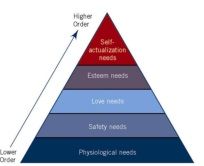
|
|
|
ERG Theory (Alderfer)
|
Existence needs – concerned with sustaining human existence & survival and covers physiological & safety needs of a material nature
Relatedness needs – concerned with relationships to the social environment and covers love or belonging, affiliation, and meaningful interpersonal relationships Growth needs – concerned with the development of potential and covers self-esteem & self-actualisation |
|
|
Two-Factor Theory (Herzberg)
|
Hygiene factors:
Elements of the job context. Sources of job dissatisfaction. Satisfier factors: Elements of the job content. Sources of job satisfaction and motivation. |
|
|
Expectancy Theory (Vroom)
|
Key expectancy theory variables:
Expectancy — belief that working hard will result in desired level of performance. Instrumentality — belief that successful performance will be followed by rewards. Valence — value a person assigns to rewards and other work related outcomes. M = E x I x V If either E, I, or V is low, motivation will be low. |
|
|
Equity Theory (Adams)
|
Employees mentally construct outcome-to-input ratios for themselves and their referent other and “socially compare”
If equity exists: Outcome/Input Self = Outcome/Input Reference person, employees experiences no tension and persist at their current level of effort However, when: Outcome/Input Self =/= Outcome/Input Reference person, tension is created and employees are “motivated” to restore equity |
|
|
Goal-setting Theory (Locke)
|
Motivational effects of task goals:
Provide direction to people in their work. Clarify performance expectations. Establish a frame of reference for feedback. Provide a foundation for behavioral self- management. |
|
|
Motivation and Performance at Work (formula)
|
Performance = function(ability x motivation)
To increase performance, you need to do one of or both of the following: Enhancing employee’s ability Fostering a motivating work environment |
|
|
To motivate...
|
Set clear, effective goals
Remove the obstacles to performance Reinforce performance enhancing behavior Use Salient Rewards Equitable process Provide Accurate and Effective Feedback |
|
|
Some conflict is good because:
|
better decisions
reexamine assumptions Improves responsiveness to external environment Increases cohesion within |
|
|
Causes of Organizational Conflict
|
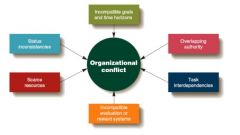
|
|
|
Diagnosing the Potential Causes of Conflict
|
Personal differences in values, work experience, cognitive styles, priorities, expectations, etc.
Information deficiencies caused by poor communication, leading to misinterpret or misunderstanding. Role incompatibility stems from conflicting expectations, pressures from job assignments, and incompatible goals and responsibilities. Environmental stress stems from budget reductions, other resource scarcities |
|
|
Conflict Management Process/Model
|
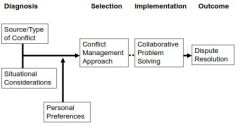
|
|
|
Conflict Management Approaches
|

|
|
|
Conflict Management Approaches (when to use)
|
Forcing: emergencies, when only one
right way exists, prevent others from taking advantage Avoiding: small issue, limited time/resources Compromising: late in conflict, when partial win is better than none for both parties Accommodating: keeping harmony, using small favour to get larger one Collaborating: for important issues when time is not a problem, where organizational support exists, when win-win solution is possible |
|
|
Difference between groups and teams
|
Two characteristics distinguish teams from
groups: Intensity with which team members work together Presence of a specific, overriding team goal or objective |
|
|
Factors Influencing Group Cohesiveness and
Performance |
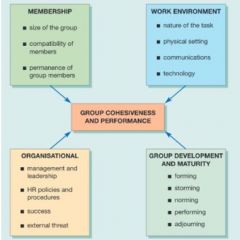
|
|
|
Stages of Team Development (Tuckman)
|
Proposed by Bruce Tuckman in 1965, initially
included four stages: Forming Storming Norming Performing A fifth stage was added to the model in 1977: Adjourning |
|
|
Belbin’s Nine Team Roles
|
Plant: someone who is creative free-thinking, and
responsible for come up with innovative solutions. Resource Investigator: performing external facing roles. Co-ordinator: responsible for allocating tasks and helping others focus on their tasks. Shaper: task-focused role, who is responsible for keeping things moving. Monitor Evaluator: one who can objectively assess progress and performance. Teamworker: oil between the cogs that keeps the machine that is the team running smoothly. Implementer: takes their colleagues' suggestions and ideas and turns them into positive action. Finisher: a perfectionist who is good at finishing touches. Specialist: experts in their own field of responsibilities. |
|
|
Characteristics of Effective Teamwork
|
A team whose membership, size and resources match the task
Good leadership and attention to team-building Commitment by team members to understand and identify with one another's goals The development of team goals – a shared vision A sense of common ownership of the task at hand and joint responsibility for its achievement Co-ordinated effort and planned sharing of tasks evenly across the team The open exchange of information within the team Honesty and frankness among team members. |
|
|
Elements of an Organisational Control System
|
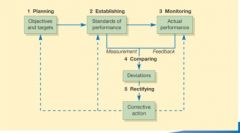
|
|
|
Types of Power
|
Coercive Power: use of threat to make people do
certain things Remunerative (Reward) Power: use rewards, perks, new projects or training opportunities, better roles and monetary benefits to influence people. Normative Power: relies on the allocation and the manipulation of symbolic rewards, for example, esteem and prestige. |
|
|
Delegation & Empowerment
|
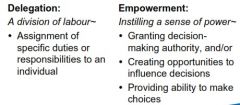
|
|
|
Advantages of Delegation
|
Increases manager’s discretionary time
Develops subordinate capabilities Demonstrates confidence in delegates Enhances commitment of delegates Improves decision making Increases efficiency Fosters work integration by manager coordination |
|
|
Barriers to Delegation
|
Lack of confidence
Fear Vanity Insecurity Self -importance |
|
|
Delegation Best Practices
|
Begin with the end in mind
Delegate broadly Support Participation in delegation Establish Parity Between Authority and Responsibility Work within the Organizational Structure Provide Adequate Support Focus Accountability on Results Delegate Consistently Choose the right people Communicate Avoid Upward Delegation |
|
|
Empowerment Best Practices
|
Articulate a clear vision and goals
Help them to master challenges Model the correct behavior Provide support Arouse positive emotions Provide good information Provide necessary resources Connect to outcomes Be fair, reliable, open, caring, and competent |
|
|
Corporate Social Responsibility (CSR) includes:
|
Community investment
Human rights Employee relations Environment practice Ethical conduct |
|
|
Benefits of CSR for Businesses
|
Stronger performance and profitability
Improved relations with the investment community and access to capital Enhanced employee relations and company culture Risk management and access to social opportunities Stronger relationships with communities and legal regulators |
|
|
Layers of Corporate Responsibilities
|
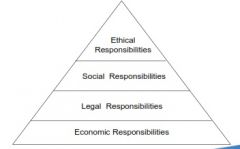
|
|
|
Elements of an effective ethics programme
|

|
|
|
What is Culture?
|
Culture is “a set of values, attitudes, beliefs, and meanings that are shared by the members of a group or organisation”.
It is often the primary way in which one ‘group’ (organisation, team, etc.) differentiates itself from others. Reflects the underlying assumption about the way work is performed, what is acceptable and not acceptable, and what behaviour and actions are encouraged and discouraged |
|
|
Benefits of Embracing Change
|
An Organisation Perspective:
Change provides opportunity for business growth. It gives the opportunity to develop solid strategic planning and tactical maneuvers. It can create more efficient processes and systems. It enables organisations to adapt and respond quicker than competition. It reduces the status quo mentality. It promotes system thinking and long term vision. It brings on innovation. It encourages proactive approach to risk management. It's a lot more interesting than something that is static and stable all the time. An Individual Perspective: Change provides personal growth, through learning new skills. It makes people more adaptable to new situations, new environments, and new people. It provides opportunity for improvement in personal life. Changes bring new beginnings and excitement to life. |
|
|
Lewin’s 3-Step Change Model
|

|
|
|
Essential Steps to Successful Change
|
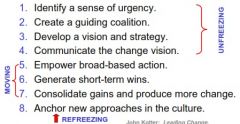
|
|
|
Sources of Individual Resistance to Change
|

|
|
|
Sources of Organizational Resistance to Change
|
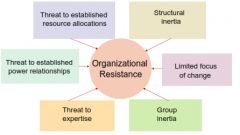
|
|
|
Overcoming Resistance to Change
|
Education and Communication
Best used: When information is lacking inaccurate. Participation and Involvement Best used: Where initiators lack information, and others have power to resist. Facilitation and Support Best used: Where people resist because of adjustment problems. Negotiation and Agreement Best used: Where one group will lose, and has considerable power to resist. Manipulation and Co-opting Best used: Where other tactics won’t work or are too expensive Explicit or Implicit Coercion Best used: When speed is essential, and initiators have power. |

